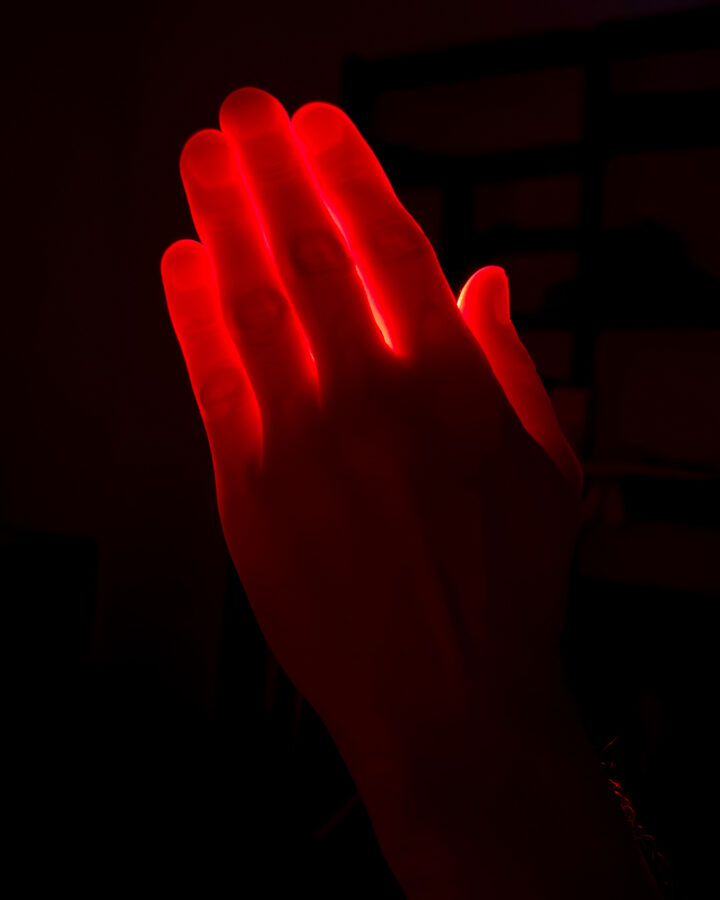The Health Benefits of Infrared Light

Infrared light therapy delivers benefits for pain, skin, mood and healing. Here’s a breakdown of the science of light therapy.
First explored in the 1960s and then taken up by NASA in the 1980s, infrared light therapy has found its way into the contemporary wellness world, offering some legitimate health benefits — and much intriguing speculation.
Before we get into all the potential benefits of infrared (IR) light, what is it?
What is Infrared Light Therapy?
In short, IR is a form of electromagnetic radiation given off by, well, everything — the sun, a body, a warm sidewalk, a cell phone — producing wavelengths that are mostly invisible to the human eye, though it’s often felt as heat.
Therapeutically, IR is used at very low to low levels in the form of LED panels, beds, and lamps, lasers, hand-held wands, face masks, and even fabrics. These tools deliver IR directly to the skin, where it penetrates tissue and triggers photobiomodulation (PMB), a mechanism that stimulates cellular activity and circulation.
Types of Light Therapy: Red, Near, Mid, and Far Infrared Benefits
Light therapy is categorized into wavelengths, measured in nanometers (nm), that penetrate at different depths to provide therapeutic benefits.
- [red lyt ther-uh-pee]nounThe use of low-wavelength red light to promote healing.Learn More (630 to 660 nm). This visible, low-level light is used for surface-level skin treatments and is often combined with near-infrared light (NIR) to stimulate cellular repair to reduce the signs of aging, regrow hair, and other possible benefits. “It dilates blood vessels in the areas where you shine the light and increases energy production. It stimulates the [mahy-tuh-kon-dree-uh]nounOrganelles in cells responsible for producing energy (ATP), often called the powerhouse of the cell.Learn More to produce more energy,” says Scott Sherr, board-certified internal medicine physician specializing in Health Optimization Medicine.
- Near-infrared (NIR) 700–1,400 nanometers (nm): This wavelength penetrates deeply, and is used for muscle recovery, pain relief, tissue rejuvenation, and cellular repair.
- Mid-infrared (MIR) 1,400–3,000 nm: This lesser-used IR has a more moderate penetration, and has been found to support relaxation, circulation, and [in-fluh-mey-shuhn]nounYour body’s response to an illness, injury or something that doesn’t belong in your body (like germs or toxic chemicals).Learn More reduction.
- Far-infrared (FIR) 3,000 nm–1 millimeter (mm): With the longest wavelength but the most shallow penetration, FIR is used primarily in infrared sauna, and through at-home mats. It heats the skin and the underlying blood vessels, triggering physiologic responses that may benefit cardiac health and reduce oxidative stress.
How Infrared Therapy Works
Exactly how IR delivers all the varied benefits isn’t fully understood. But most stem from cellular responses triggered when IR penetrates the skin and underlying tissues. Some of the mechanisms involved may include:
- Enhanced ATP production: IR may prompt mitochondrial energy output, improving cellular function and tissue repair.
- [nahy-trik ok-sahyd]nounA molecule produced naturally in the body that relaxes blood vessels, improves circulation, and supports heart and brain function.Learn More release: This signalling molecule helps relax blood vessels, improving circulatory function and enhancing blood and oxygen delivery.
- Modulation of inflammatory pathways: By influencing cellular signalling, IR may temper the inflammatory response.
- Antioxidant enhancement: IR may improve the body’s antioxidant defenses by stimulating cellular repair.
6 Benefits of Infrared Light Therapy
IR is increasingly used in health and medical settings to support surgical treatments and for therapeutic applications. Here are some of the researched benefits:
1) Pain
- A review of small randomized clinical trials found that PBM laser therapy significantly reduced post-surgical acute pain.
- The same review featured two studies on women over 60 diagnosed with osteoarthritis, and found improvements in both pain and moh-bil-i-tee]nounThe ability to move freely and easily through a full range of motion.Learn More following IR treatments.
- Other studies found reductions in tender points and pain threshold among people with fibromyalgia. One found IR to be as effective for reducing fibromyalgia pain as the analgesic lidocaine.
- IR has also been found to reduce post-surgical inflammation, periodontal inflammation, and reduced inflammatory markers among people with chronic low-back pain. One 2021 review of the scientific literature concluded that it offered a “non-invasive, safe, drug-free and side-effect-free method of pain relief.”
2) Tissue healing
- IR has been shown to accelerate skin and soft-tissue healing, offering a useful aide post-surgery and for wound care.
- In the field of dentistry, IR is used to speed healing from procedures like extractions; offer pain relief by reducing inflammation; and even detect decay and infection.
- It’s increasingly used in ophthalmology to treat retinal injury, optic nerve trauma, and may help treat macular degeneration.
- It’s commonly used to treat sports injuries, including muscle strains and sprains, and shows promise in the detection of certain musculoskeletal injuries.
3) Cardiac health
- A review of the scientific literature found that IR can support blood pressure and, specifically mild hypertension and conditions of congestive heart failure, benefitting cardiac health at a similar level to walking at a moderate pace.
4) Enhanced well-being
- One small study found that morning exposure to NIR five days a week over one month during winter had a positive impact on well-being overall, improving mood, reducing drowsiness, and lowering resting heart rate. Meanwhile, those receiving the highest dose of NIR also experienced changes in immune modulation. The effects were not detected during summer months.
5) Skin Quality
- Red light therapy’s potential to increase collagen production, improve the appearance of fine lines, and improve skin quality has propelled a robust consumer market for masks, lamps, and wands promising to turn back the hands of time. Do they work? Possibly, but the results won’t be as dramatic as in-office dermatology procedures, and may vary from person to person. Here’s what the research shows:
- Skin quality: Using an IR silicon mask for 15-20 minutes, five times per week, over six months improved skin quality, including reduced roughness and improved tightness, and offered some improvement in the appearance of fine wrinkles, according to a small Korean study with 20 participants. No significant changes in hyperpigmentation were found.
- Wrinkles: Three months’ use of a red light therapy mask reduced the appearance of wrinkles, sagging skin, and oiliness, and improved skin elasticity and texture, according to a very small cosmetic industry study of 20 volunteers.
- Clarity: Improvements in the appearance of acne lesions and a decrease in oiliness after twice-weekly IR laser use over three weeks, according to another small study of 27 women with mild to severe acne.
The American Academy of Dermatology association recommends at-home red-light tools only as a complementary therapy to more powerful, in-office treatments, such as microneedling, chemical peels, or medicated creams.
Emerging Uses of Infrared Light Therapy
Clearly infrared therapy has already proven useful for many health applications, and there may be more to come. The technology is also being studied for:
- treating depression and anxiety
- supporting cognitive function
- managing diabetic [in-suh-lin ri-zis-tuhns]nounA condition where cells in the muscles, fat, and liver don’t respond properly to insulin, leading to impaired insulin sensitivity and potentially prediabetes or type 2 diabetes.Learn More
- managing kidney disease
- alongside other light wavelengths and photosynthesizing agents, in targeting abnormal and cancerous cells
Is Infrared Therapy Safe? Risks and Considerations
Infrared therapy is widely considered a safe, non-invasive therapeutic treatment. However, when used too much or improperly, there is the possibility of skin irritation or more serious consequences, such as eye damage or burns. People with darker skin tones may be more susceptible to hyperpigmentation from IR.
Although infrared saunas emit lower temperatures than traditional saunas, people should use similar precautions: stay hydrated, and consult with a medical professional first if you have extremely low or high blood pressure, an unstable heart condition, or are pregnant, among other conditions.
It’s generally recommended to start any IR therapy at low intensity and duration, and to increase exposure gradually.
Read This Next
The information provided in this article is for educational and informational purposes only and is not intended as health, medical, or financial advice. Do not use this information to diagnose or treat any health condition. Always consult a qualified healthcare provider regarding any questions you may have about a medical condition or health objectives. Read our disclaimers.

